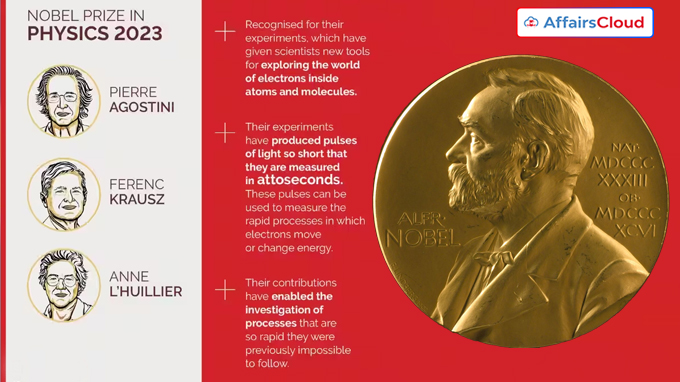 Anne L’Huillier of France, Pierre Agostini of France, and Ferenc Krausz of Hungary were awarded the 2023 Nobel Prize in Physics “for experimental methods that generate attosecond pulses of light for the study of electron dynamics in matter.”
Anne L’Huillier of France, Pierre Agostini of France, and Ferenc Krausz of Hungary were awarded the 2023 Nobel Prize in Physics “for experimental methods that generate attosecond pulses of light for the study of electron dynamics in matter.”
- The Nobel Prize in Physics is awarded by the Royal Swedish Academy of Sciences, Stockholm, Sweden.
- Anne L’Huillier is the fifth woman to receive the Nobel Prize in Physics.
Winners of the Nobel Prize in Physics 2023:
| Nobel laureates | Awarded For |
|---|---|
| Anne L’Huillier | For experimental methods that generate attosecond pulses of light for the study of electron dynamics in matter |
| Pierre Agostini | |
| Ferenc Krausz |
Click here to view official link
Prize Money: Recipients of the Nobel Prize are presented with a Nobel Prize diploma(certificate), a gold medal, and a cash award. The Nobel Prize amount for 2023 is set at Swedish kronor (SEK) 11 million per full Nobel Prize.
About the laureates:
i.Anne L’Huillier: Anne L’Huillier was born in 1958 in Paris, France.
- Anne L’Huillier currently working as a Professor at Lund University, Sweden.
ii.Pierre Agostini: Pierre Agostini was born in 1941 in Tunis, Tunisia.
- Pierre Agostini currently working as a Professor at The Ohio State University, Columbus, the United States of America(USA).
iii.Ferenc Krausz: Ferenc Krauszwas was born in 1962 in Mór, Hungary.
- Ferenc Krausz Ferenc Krausz currently working as a Director at Max Planck Institut of Quantum Optics, Garching (Germany), and a Professor at Ludwig-Maximilians- Universität München, Germany.
 Problems with finding electron dynamics:
Problems with finding electron dynamics:
i.Atoms move in the order of femtoseconds(10^−15 seconds), which can be studied with the very shortest pulses produced by a laser.
ii.Electrons are the negatively charged particle that moves around the nucleus of an atom.
- Electrons move in the order of attosecond (10^-18 Second).
- For an understanding, the time scale between the attosecond to one second is equal to one second to the age of the universe.
- The movement of electrons can be found by light pulses with a duration of a few attoseconds.
Note:
To measure the faster events, the measurement must be done more quickly than the time taken by the event. In order to capture the movements of an electron that moves in attoseconds, we must use a measurement system in attoseconds time scale.
Pathway for the creation of attosecond pulses:
i.Anne L’Huillier Findings:In 1987, Anne L’Huillier and her colleagues did an experiment of passing an infrared laser beam through a noble gas that produces overtones.
- Each overtone is a light wave with a given number of cycles for each cycle in the laser light.
- Anne L’Huillier’s discoveries laid the foundation for subsequent breakthroughs.
ii.Pierre Agostini Findings: Pierre Agostini and his research group in France successfully created and investigated a pulse train of 250-attosecond light pulses in 2001.
iii.Ferenc Krausz Findings: Ferenc Krausz and his team in Austria developed a technique to separate an individual 650-attosecond pulse from a pulse train.
- With the 650-attosecond pulse, it is possible to track and study a process by which electrons were away from their atoms.
The chronology of the discoveries made it possible to access the attosecond world.
Facts on the Nobel Prize in Physics:
i.The Nobel Prize in Physics has been awarded 117 times to 225 laureates between 1901-2023.
- As John Bardeen was awarded the Nobel Prize in Physics twice, 224 individuals have been awarded the Nobel Prize in Physics since 1901.
ii.Youngest physics laureate: William Lawrence Bragg was awarded the Nobel Prize in Physics in 1915 at the age of 25 jointly with his father William Henry Bragg
iii.Oldest physics laureate: Arthur Ashkin was awarded the Nobel Prize in Physics in 2018 at the age of 96, remains the youngest Nobel laureate for physics.
ivFemale physics laureate:
- Five women were awarded the Nobel Prize in Physics out of 224 individuals since 1901.
v.Multiple physics laureates:
- John Bardeen was the only person awarded the Nobel Prize in Physics twice in 1956 and 1972.
vi.Family Nobel Prize laureates in physics:
- Marie Curie and her husband Pierre Curie were awarded the Nobel Prize in Physics in 1903.
The following father and son duo was awarded the Nobel Prize in Physics
- Niels Bohr(1922) and Aage Niels Bohr (1975).
- Manne Siegbahn(1924) and Kai M. Siegbahn (1981).
- J. J. Thomson (1906) and George Paget Thomson (1937).
- Sir William Henry Bragg and William Lawrence Bragg(1915).




